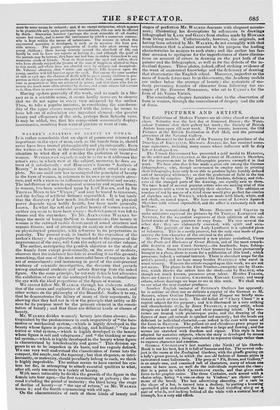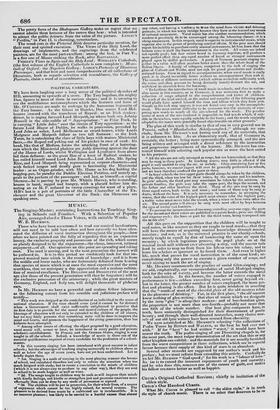PICTURES AND ARTISTS.
THE Exhibitions of Modern Pictures are all either closed or about to close. Saturday was the last day at Somerset House ; the Water- colour Painters shut their gallery last week ; the Society of British Artists keep open till next week. There remain, however, the Old Pictures at the British Institution in Pall Mall, and the perennial attraction of the National Gallery. The Memorial to the Lords of the Treasury for the purchase of the Drawings of EAITAELI.E, MICHAEL ANGELO, &c. has received mime. rous signatures, including many names whose influence will be duly felt at head-qua: tass. The French Government has presented a gold medal to Hartrusto, as the artist and HCLLMANDEL as the printer of HARDING'S Sketches, for the improvements in the lithographic process exemplitd in that
work. We hear also that it has made a great stir among the German lithographers; who, though accustomed to employ tints in printing their lithographs, have only been able to produce lights harshly defined
and of unvarying whiteness ; so that the gradations of light in the tint take them by surprise. The painter-like freedom, delicacy, and rich. ness of the stumped parts of the drawing, are equally new to them. We have heard of several popular artists who are making trial of this new process with a view to multiply their sketches. The addition of touches of red by menus of a third stone would give perfect fac-similes of sketches such as Wir.xie's, which are made with black, white, and red chalk, on tinted paper. We have seen seine of LEWIS'S Spanish Sketches with colour superadded, and the effect is extremely rich and brill man% lhalav is commissioned by Messrs. HonesoN and GRAVES to make miniature copies of the pictures by Sir THOMAS LAWRENCE and NEWTON, for the mezzotint engravers of their editition of the col- lected works of these painters to copy from. We saw several the other day: they are elaborately executed, with spirit and ACM. "icy. The portrait of the late Lady Lyndhurst is a splendid piece of colouring. This is a costly process, but the only sure mode of pre. serving the trim character of the original in the plate. Messrs. Fisnmal have commenced a new picture periodical, Views of the Ports and Harbours of Great Britain, and of the most remark-
able features of our Coast Scenery,—the headlands, bays, fishing.
stations, Since STANFIELD'S Coast Scenery has been prematurely
brought to a close, there is room for a publication of this kind ; which possesses, indeed, a national interest. There is abundant scope for the
artist's pencil ; and we have many besides STANFIELD who excel in coast scenery. Who are the artists engaged upon this work, we are not yet aware. The plates in the First Number—excepting one by HARD- ING, which throws the others into the shade—are by BALMER, who though not much known, possesses great talent. Besides TURNER, there are COPLEY FIELDING, CHAMBERS, EDWARD COOKE, and many others, whose drawings we hope to see in this work. We shall watt to see what the next number produces.
Another English imitator of RETzscir's Outlines has appeared :
Ire is neither so close nor so delicate a copyist of the German as M. SELOLTS, whose Outline Illustrations of the Tempest we briefly men-
tioned a week or two back. The old ballad of " Chevy Chase" is a capital subject for the purpose ; and it is illustrated in a very striking and characteristic style, by JohN FRANKLIN, a young artist, whose designs are bold and dashing, and slim promising talent. The cos- tumes are treated with picturesque gusto, and the drawing of the figures of men and animals is spirited and masterly; but the heads are
deficient in individual character,—as indeed is the case with some of the faces in BETTSCH. The gallant air and chivalrous grace proper to the subject are well expressed; the outline is large and flowing ; and the scenes are sketched with freedom and vigour. This style is best adapted for narrative subjects, where the story is developed by means of action and scenery ; being calculated to represent things rather than to express character and emotion. GEORGE CRIIIKSHANK'S last number (the Ninth) of his Sketch. Book is not his best, but it is full of humour and fun. The newest sub- ject is the scene at the Zoological Gardens, with the giraffe grazing on a lady's green parasol, in which the new-old fashion of female attire as caricatured most ludicrously. The peep at " Pit, Boxes, and Gallery," is an ample one, and crammed full of characters, many of whom one seems to have seen, so well do the individuals represent the class: this is a point in which CRUIKSIIANK excels, and that gives such force to his graphic satire. The three Cocknies, each armed with a chaise-whip, hiring " a vun-os-chay to Vindsor," are choice spec!. mens of the breed. The last advertising absurdity, of a cart in the shape of a hat, is turned into a drollery, by putting a knowing spectacled phiz underneath the hat : the head trundling along on a pair of wheels, mid looking behind all the while with a comical leer of triumph, has a very odd effect. The pretty faces of the Shakspeare Gallery make us regret that we cannot admire them because of the names they bear : what is intended to attract the public detracts from the value of the picture. LESLIE'S " Perdita," in Part II. is charming, nevertneless. The wood-cuts in the Pictorial Bible deserve particular mention, for their neat and spirited execution. The Views of the Holy Land, the drawings of implements, and the engravings from the celebrated painters, are for the most part excellent : among the last, in Part V., Is a fine one of Moses striking the Rock, after RAFFAKLLE. FISHER'S Views in Syria and the Holy Land; WINKLES'S Cathedrals, (the first volume of the English Cathedrals is now complete); Memo. vials of Orford; the Napoleon Gallery ; LODGE'S Portraits of Illustrious Personages; and that best and most comprehensive of all collections of likenesses, both as regards selection and resemblance, the Gallery if Portraits, claim a word of remembrance.



























 Previous page
Previous page